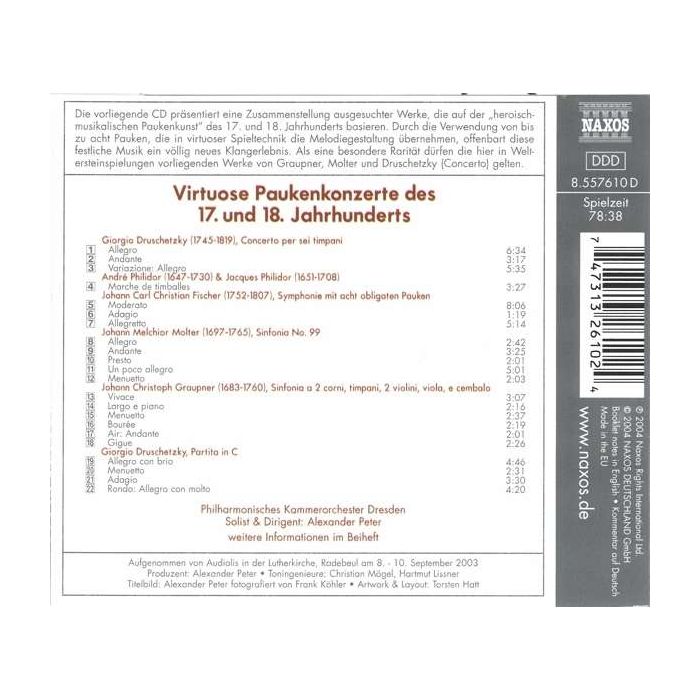
(Produkt nie został jeszcze oceniony)
kompozytor
różni kompozytorzy
tytuł
VIRTUOSO TIMPANI CONCERTOS
pełny spis kompozytorów
Druschetzky, Georg, Fischer, Johann Carl Christian, Graupner, Christoph, Molter, Johann Melchior, Philidor, François-André Danican, Philidor, Jacques, różni kompozytorzy
wykonawcy
Dresden Philharmonic Chamber Orchestra, Peter, Alexander
nr katalogowy
8.557610
opis
The works on this recording present some interesting differences from the normal eighteenthcentury usage of two timpani with two trumpets in which the timpani play the tonic and dominant notes of the key. These avant-garde attempts to use more than two pitches to reinforce the harmonic or melodic structure of the music are paralleled in more recent works using pedal mechanisms developed in the midnineteenth and twentieth centuries.
The timpani of the eighteenth and early nineteenth centuries were much smaller in diameter than those in normal use today. The typical pair often measured about eighteen and twenty-one inches in diameter, with a shallow depth of about twelve to fifteen inches. The slackness of the thick calf or goat-skin heads played by very hard sticks gave a different sound, less resonant and generally softer in dynamic impact that what is heard today. The larger size of our modern timpani (the largest drums in common use measure 32 inches in diameter) thus create some different problems for the modern timpanist who attempts to play the multiple timpani works. Alexander Peter performs on eighteenthcentury style drums mounted with goat-skin heads and played upon with wooden sticks. Note the varying tone colours he produces within these simple parameters.
The timpani of the eighteenth and early nineteenth centuries were much smaller in diameter than those in normal use today. The typical pair often measured about eighteen and twenty-one inches in diameter, with a shallow depth of about twelve to fifteen inches. The slackness of the thick calf or goat-skin heads played by very hard sticks gave a different sound, less resonant and generally softer in dynamic impact that what is heard today. The larger size of our modern timpani (the largest drums in common use measure 32 inches in diameter) thus create some different problems for the modern timpanist who attempts to play the multiple timpani works. Alexander Peter performs on eighteenthcentury style drums mounted with goat-skin heads and played upon with wooden sticks. Note the varying tone colours he produces within these simple parameters.
This recording presents several styles of music for more than two timpani. The phrase "multiple timpani" music aptly describes it. The duet by the Philidor brothers typifies the older semi-improvised style used by military drummers. The works by Molter and Graupner are elegant symphonic examples of court music in which the timpanist enhances the bass, Fischer continues in this tradition but includes more soloistic passages, and Druschetzky displays the virtuosic capabilities inferred by Altenberg and articulated by Kastner.
nośnik
CD x 1
wydawca
Naxos
data wydania
11.07.2005
EAN / kod kreskowy
747313261024
58,00 zł
Produkt na zamówienie
Wysyłka ustalana indywidualnie.
Darmowa wysyłka dla zamówień powyżej 300 zł!
Darmowy kurier dla zamówień powyżej 500 zł!
sprawdź koszty wysyłki